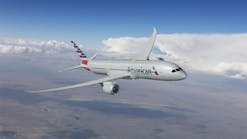On Nov. 7, during the late-afternoon rush at Chicago's bustling O'Hare International Airport, something truly astonishing happened. Pilots, managers and mechanics looked up from their ground positions at the United Airlines terminal and saw an odd, disc-shaped object hovering silently overhead, just below the overcast.
Some minutes later, with many eyes now fixated on it, the wingless vehicle shot straight up at an incredible speed and was gone, leaving a crisp hole through the clouds with blue sky visible at the top.
It was definitely not an airplane, or any known craft, witnesses said, many of them shaken by what they saw.
"I immediately called our operations center to confirm the sighting and the Federal Aviation Administration was contacted while I drove to the other concourse to talk to the witnesses," a United management employee wrote for a National Unidentified Flying Object Reporting Center (NUFORC) investigation.
With NUFORC's input, Chicago Tribune transportation reporter Jon Hilkevitch broke the story in January, which then leapt onto national television news. "The witness credibility is beyond question," says Hilkevitch, who has spoken to dozens of witnesses.
The FAA and United Airlines initially denied knowing anything about the incident, but taped calls and other evidence revealed their communications about it when it occurred.
The FAA then attributed the incident to a "weather phenomenon" and United Airlines advised employees not to talk about it, according to the Tribune.
"The safety implications of any vehicle operating at low altitude over a major airport outside the authority of air-traffic control are obvious," says NASA aviation expert Brian E. Smith, a former manager in the agency's Aviation Safety and Security Program. "Managers should want to hear about such vehicle operations before they become accidents or disasters."
Instead, United witnesses have been disregarded and left to ponder their unsettling observations.
FAA spokesman Tony Molinaro said in January that the "absence of any kind of factual evidence" precludes an investigation. "No FAA controller saw anything. There was nothing on radar either."
Nonetheless, he offered his best "guess": Witnesses could have seen a "hole-punch cloud" in "a perfect circular shape like a round disc" with "vapor going up into it."
In fact, these natural cloud holes - with ice crystals falling down through them, not up - can only form at below-freezing temperatures. It was 48 degrees Fahrenheit in the O'Hare cloudbank that afternoon.
A hole could also form in a cloud from rapid evaporation by heat or very dry air, scientists say. This explanation, unlike Molinaro's, fits witness descriptions of a high-energy, round object likely emitting intense heat or other radiation while ascending.
Some experts say radar cannot pick up unrecognizable objects with bizarre behaviors. John Callahan, division chief of accidents and investigations for the FAA during the 1980s, says it's not at all surprising that the O'Hare UFO was undetected on radar - but that doesn't mean that there was nothing there.
Radar technology cannot always capture extremely high-speed UFOs. A hovering object wouldn't necessarily show up, either.
Callahan speaks from direct experience that makes him an authority on the FAA's handling of UFO incidents. In 1986 he reviewed extensive data generated by a Japan Airlines cargo B747 encounter with a gigantic, walnut-shaped UFO over Alaska.
Later, the FAA declared the radar faulty, ignored the three pilot eyewitness accounts, and called the incident "unconfirmed."
To this day, Callahan fervently disputes these findings based on data still in his possession. "I observed a primary radar target in the position reported by the Japanese pilot," the former official says, which, although intermittent, synchronized with the 30-minute taped interchange between pilots and controllers.
Official policy actually spells out FAA lack of interest in reports of anomalies, even if the unidentified craft is potentially life-threatening. The FAA Aeronautical Information Manual, providing the fundamentals required for flying in U.S. airspace, states that "persons wanting to report UFO/Unexplained Phenomena activity" should contact an organization such as NUFORC.
If "concern is expressed that life or property might be endangered," the manual says, "report the activity to the local law-enforcement department."
Smith takes issue with this approach. "We need to encourage reporting of all incidents regardless of biases against particular categories of occurrences," he says.
Richard Haines, a former NASA official and now director of the National Aviation Reporting Center on Anomalous Phenomena, has collected over a hundred reports from pilots documenting a range of safety hazards caused by proximity to unfamiliar flying objects or inexplicable brilliant lights.
How could our government not be interested in an unknown, highly technological object hovering over a major airport, as reported by competent airline personnel? What about passenger safety? Or national security? Or just plain scientific curiosity?
Unless the FAA and other federal agencies shift gears, this mind-boggling incident at O'Hare will be left to haunt us - until the next time, when something even more alarming could happen.
(Leslie Kean is a New York investigative journalist and co-founder of the Washington-based Coalition for Freedom of Information.)
Copyright 2005 LexisNexis, a division of Reed Elsevier Inc. All rights reserved.
Terms and Conditions | Privacy Policy
News stories provided by third parties are not edited by "Site Publication" staff. For suggestions and comments, please click the Contact link at the bottom of this page.





